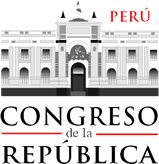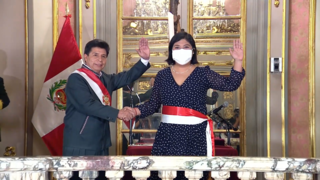
The Congress of the Republic of Peru is the unicameral body that assumes legislative power in Peru. Due to broadly interpreted impeachment wording in the Constitution of Peru, the President of Peru can be removed by Congress without cause, effectively making the legislature more powerful than the executive branch. Following a ruling in February 2023 by the Constitutional Court of Peru, the body tasked with interpreting the Constitution of Peru and whose members are directly chosen by Congress, judicial oversight of the legislative body was also removed by the court, essentially giving Congress absolute control of Peru's government. Since the 2021 Peruvian general election, right wing parties held a majority in the legislature. The largest represented leftist party in Congress, Free Peru, has subsequently aligned itself with conservative and Fujimorists parties within Congress due to their institutional power.

The Political Constitution of Peru is the supreme law of Peru. The current constitution, enacted on 31 December 1993, is Peru's fifth in the 20th century and replaced the 1979 Constitution. The Constitution was drafted by the Democratic Constituent Congress that was convened by President Alberto Fujimori during the Peruvian Constitutional Crisis of 1992 that followed his 1992 dissolution of Congress, was promulgated on 29 December 1993. A Democratic Constitutional Congress (CCD) was elected in 1992, and the final text was approved in a 1993 referendum. The Constitution was primarily created by Fujimori and supporters without the participation of any opposing entities.

Gustavo Andrés Gorriti Ellenbogen is a Peruvian journalist known for his reporting on rebel groups, government corruption, and drug trafficking. In 2011, the European Journalism Centre described him as having "been awarded more prizes than probably any other Peruvian journalist". He is the founder of IDL-Reporteros.
The mass media in Peru includes a variety of different types of media, including television, radio, cinema, newspapers, magazines, and Internet-based web sites. Much of the print-based media in Peru is over a century old, with some newspapers even dating back to the time of independence.

Popular Force, known as Force 2011 until 2012, is a right-wing populist and Fujimorist political party in Peru. The party is led by Keiko Fujimori, former congresswoman and daughter of former President Alberto Fujimori. She ran unsuccessfully for the presidency in the 2011, 2016 and 2021 presidential elections, all losing by a narrow margin.

Fujimorism is the policies and the political ideology of former President of Peru Alberto Fujimori as well as the personality cult built around him, his policies and his family, especially Keiko Fujimori. The ideology is defined by authoritarianism, its support for neoliberal economics, opposition to communism, and socially and culturally conservative stances such as opposition to LGBT rights and school curriculums including gender equality or sex education. Opponents of Fujimorism are known as anti-Fujimorists.

José Pedro Castillo Terrones is a Peruvian politician, former elementary school teacher, and union leader who served as the President of Peru from 28 July 2021 to 7 December 2022. Facing imminent impeachment proceedings, on 7 December 2022, Castillo attempted to illegally dissolve Congress and rule by decree. In response, the Congress of the Republic of Peru impeached him, resulting in his removal from office.
Fascism in Peru comprises a number of movements and parties in Peru which espoused and promoted fascism in the South American nation. Peru experienced fascist-led governments through the 1930s, though its popularity declined in the 1940s during World War II. Into the twenty first century, neofascism has emerged in Peru, especially during the Peruvian political crisis.

Since 2016, Peru has been plagued with political instability and a growing crisis, initially between the President, Pedro Pablo Kuczynski and Congress, led de facto by Keiko Fujimori. The crisis emerged in late 2016 and early 2017 as the polarization of Peruvian politics increased, as well as a growing schism between the executive and legislative branches of government. Fujimori and her Fujimorist supporters would use their control of Congress to obstruct the executive branch of successive governments, resulting with a period of political instability in Peru.

General elections were held in Peru on 11 April 2021. The presidential election, which determined the president and the vice presidents, required a run-off between the two top candidates, which was held on 6 June. The congressional elections determined the composition of the Congress of Peru, with all 130 seats contested.

Free Peru, officially the Free Peru National Political Party, is a Marxist political party in Peru. Founded in 2008 as the Free Peru Political Regional Movement, the party was officially constituted as a national organization in February 2012 by the name of Libertarian Peru. It was registered as a political party in January 2016 and adopted its current name, Free Peru, in January 2019. Its presidential candidate Pedro Castillo won the 2021 Peruvian general election against Popular Force nominee Keiko Fujimori. Free Peru has the second most seats in the Congress of Peru, with 22 out of 130 total representatives; however, its opposition continued to rule Congress after forming a larger alliance of seats led by the Popular Action party. Free Peru is a participant in the São Paulo Forum, an annual conference of leftist parties in the Americas.
Events in the year 2021 in Peru.
Karelim Lisbeth López Arredondo is a Peruvian businesswoman and lobbyist known for controversial interactions with the governments of Presidents of Peru Martín Vizcarra and Pedro Castillo.

Liz Patricia Benavides Vargas is a Peruvian lawyer. On June 20, 2022, she was elected as Attorney General of Peru and was removed from her position on 7 December 2023 as a result of the Peruvian Public Ministry controversy.

On 7 December 2022, Pedro Castillo, the then-President of Peru, made an attempt to dissolve the Congress amidst looming removal proceedings. This move included the immediate imposition of a curfew, an attempt to establish an emergency government, and a call for the formation of a constituent assembly. Prior to this, Attorney General Patricia Benavides had accused Castillo of leading a criminal organization, a claim that contravened Article 117 of the Constitution of Peru. She had urged the Congress to remove him from office, leading to the third removal attempt against Castillo. Castillo defended his actions by arguing that the Congress, which had obstructed many of his policies, was serving oligopolistic businesses and had colluded with the Constitutional Court to undermine the executive branch, thereby creating a "congressional dictatorship". He also advocated for the immediate election of a constituent assembly, a demand that had been echoed since the 2020 Peruvian protests.

Following the ousting of president of Peru, Pedro Castillo on 7 December 2022, a series of political protests against the government of president Dina Boluarte and the Congress of Peru occurred. The demonstrations lack centralized leadership and originated primarily among grassroots movements and social organizations on the left to far-left, as well as indigenous communities, who feel politically disenfranchised. Castillo was removed from office and arrested after announcing the illegal dissolution of Congress, the intervention of the state apparatus, and the forced establishment of an "emergency government", which was characterized as a self-coup attempt by all government institutions, all professional institutions, and mainstream media in Peru while Castillo's supporters said that Congress attempted to overthrow Castillo. Castillo's successor Dina Boluarte, along with Congress, were widely disapproved, with the two receiving the lowest approval ratings among public offices in the Americas. Among the main demands of the demonstrators are the dissolution of Congress, the resignation of Boluarte, new general elections, the release of Castillo, and the formation of a constituent assembly to draft a new constitution. It has also been reported that some of the protesters have declared an insurgency in Punos's region. Analysts, businesses, and voters said that immediate elections are necessary to prevent future unrest, although many establishment political parties have little public support.

The third presidential vacancy (impeachment) process against President Pedro Castillo was an action initiated by the Congress of the Republic of Peru with the purpose of declaring the "permanent moral incapacity" of the President of the Republic, Pedro Castillo, under Article 113 of the Political Constitution of Peru.

The Ayacucho massacre was a massacre perpetrated by the Peruvian Army on 15 December 2022 in Ayacucho, Peru during the 2022–2023 Peruvian protests, occurring one day after President Dina Boluarte, with the support of right-wing parties in Congress, granted the Peruvian Armed Forces expanded powers and the ability to respond to demonstrations. The clash occurred due to the protesters' attempt to storm the local airport. On that day, demonstrations took place in Ayacucho and the situation intensified when the military deployed helicopters to fire at protesters, who later tried to take over the city's airport, which was defended by the Peruvian Army and the National Police of Peru. Troops responded by firing live ammunition at protesters, resulting in ten dead and 61 injured. Among the injured, 90% had gunshot wounds, while those killed were shot in the head or torso. Nine of the ten killed had wounds consistent with the ammunition used in the IMI Galil service rifle used by the army.

Josué Manuel Gutiérrez Cóndor is a Peruvian lawyer and politician. He served as a member of the Congress of Peru from 2011 to 2016. In May 2023, he was appointed Ombudsman of Peru by Congress.

An investigation surrounding the Public Ministry of Peru, known as Operation Valkyrie V resulted with a controversy surrounding the Attorney General of Peru, Patricia Benavides, who was alleged to head a criminal organization. The scandal revolved around alleged irregularities with the decisions of electing the Ombudsman of Peru Josué Gutiérrez Cóndor, dismissing former attorney general Zoraida Ávalos and attempts to remove the members of the National Board of Justice (JNJ), all in reported attempts for Benavides to main control of the Public Ministry by nominating allies in judicial positions.















